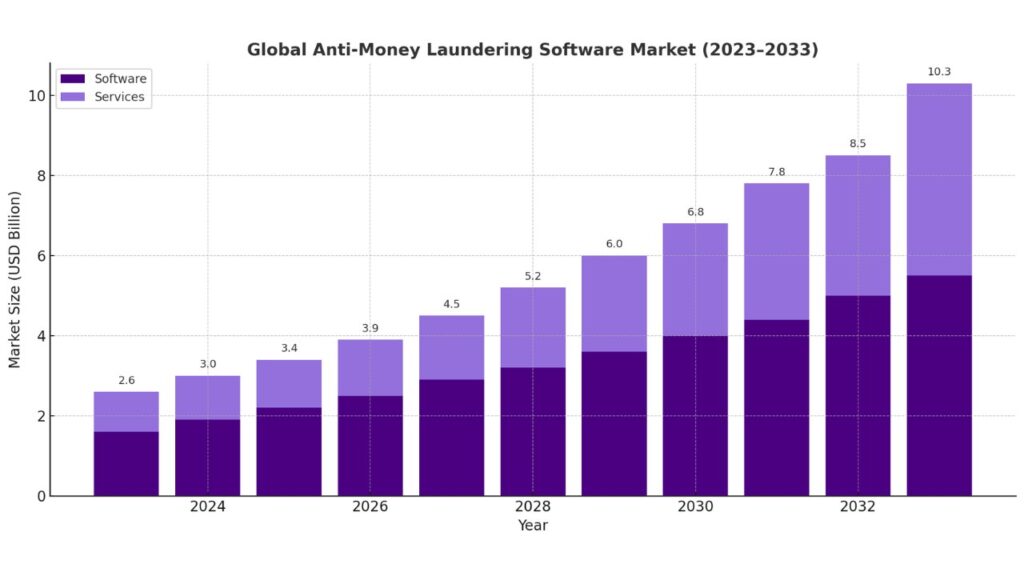In today’s increasingly regulated financial landscape, AML software development plays a crucial role in ensuring compliance and safeguarding businesses against illicit financial activities. As global financial institutions face growing scrutiny, the demand for robust anti-money laundering software development has surged, enabling companies to detect, prevent, and report suspicious transactions effectively.
This comprehensive guide explores everything you need to know about AML software development — from understanding what it is, the features it must include, to the process, benefits, and cost considerations.
What is AML Software?
AML (Anti-Money Laundering) software is a suite of digital tools designed to help financial institutions and other regulated businesses comply with AML regulations. These tools assist in monitoring customer behavior, detecting suspicious activities, and generating regulatory reports. By leveraging automation and artificial intelligence, money laundering detection software development ensures quicker, more accurate risk management.
Why Invest in Anti-Money Laundering Software Development?
Organizations, especially in finance, are legally obligated to maintain AML compliance. Failing to do so can lead to hefty penalties and reputational damage. Developing a customized AML solution enables organizations to:
- Stay compliant with international AML laws (e.g., the USA PATRIOT Act, EU AML directives)
- Reduce false positives in transaction monitoring
- Improve operational efficiency
- Minimize fraud and financial crime
Custom AML software development services can be tailored to the specific needs of banks, fintech firms, insurance companies, and even crypto platforms.
AML Software: An Industry Overview
Anti-Money Laundering (AML) software has become an essential part of the financial technology ecosystem. With increasing regulatory demands and the growing sophistication of financial crimes, companies are turning to intelligent AML platforms to automate and strengthen their compliance strategies.
According to a report by Grand View Research, the global AML software market size was valued at USD 2.3 billion in 2022 and is expected to grow at a compound is projected to expand at a steady compound annual growth rate (CAGR) of approximately 15.6% between 2023 and 2030. These systems evolve and enhance their performance as they process more data over time.The demand is driven by:
- Rising global financial regulations
- Increase in money laundering cases post-pandemic
- Surge in fintech and digital banking platforms

The Financial Action Task Force (FATF) also reported that emerging technologies like AI and blockchain are transforming the AML landscape, making monitoring systems more predictive and proactive.
Key Features of AML Software
The features of AML software define how well it can identify and mitigate risks. A robust AML platform should include:
- Customer Due Diligence (CDD)
This feature helps in identifying and verifying the identity of clients. It ensures that businesses know their customers and assess the risk they pose. Enhanced Due Diligence (EDD) can also be conducted for high-risk customers. According to a 2023 survey by Thomson Reuters, 92% of financial institutions listed effective CDD as their top AML priority. - Transaction Monitoring
Real-time or batch-based transaction analysis enables financial institutions to flag unusual patterns or large transactions that might indicate money laundering. A report by Deloitte notes that advanced analytics in transaction monitoring can reduce false positives by up to 30%. - Suspicious Activity Reporting (SAR)
Enables compliance teams to generate and submit SARs to relevant authorities when suspicious transactions are identified. According to FinCEN, over 3 million SARs were filed in the U.S. alone in 2022, highlighting the critical importance of this feature. - Risk Scoring and Profiling
Assigns risk levels to customers based on behavior, geography, occupation, and transaction patterns. High-risk profiles are monitored more rigorously. A PwC study found that integrating dynamic risk scoring improved AML case handling time by 45%. - Watchlist Screening
Cross-checks customers and transactions against global watchlists, sanctions lists, and PEP (Politically Exposed Persons) databases. Integration with sources like OFAC, UN, and EU watchlists is essential. - Automated Alerts and Workflows
Automatically flags potential threats and routes them to compliance teams for investigation, reducing manual workload and enhancing efficiency. Research from LexisNexis shows automated workflows save compliance teams an average of 20 hours per week. - Real-time Analytics
Provides actionable insights through dashboards and visualizations to understand transaction trends, high-risk activities, and compliance gaps. According to
McKinsey, banks that utilize advanced risk analytics are seeing significant improvements in decision-making accuracy and business model innovation. Deloitte also highlights how AI-powered real-time analytics enable faster identification of emerging risks.
– McKinsey on risk analytics– Deloitte on real-time risk automation - Regulatory Reporting Tools
Simplifies the preparation and submission of compliance reports as required by financial authorities. Ensures formatting and data collection meet regulatory standards. - AI & Machine Learning Integration
Uses algorithms to detect patterns, anomalies, and predict potential fraud based on historic and real-time data. These systems evolve and enhance their performance as they process more data over time. McKinsey states that machine learning can improve detection rates by up to 60%. - Dashboard and Audit Trails
Centralized dashboards provide transparency and allow tracking of all compliance activities. Audit trails ensure accountability and help in retrospective investigations. A 2023 report by NICE Actimize revealed that 78% of institutions rely on robust audit trails during AML audits.
These AML software features work together to streamline AML efforts, improve operational efficiency, and ensure continuous regulatory compliance.
AML Software Development Process
The AML software development process involves several critical stages:
1. Requirement Gathering
Understand your business model, compliance obligations, and unique user requirements.
2. Design and Architecture Planning
Develop a scalable, secure, and user-friendly platform. Modern architectures like microservices help ensure modular growth.
3. Core Development
Write clean, modular code while integrating AI and machine learning tools for pattern recognition and anomaly detection.
4. Integration of Third-Party Tools
AML systems often integrate with databases, KYC providers, and other compliance APIs.
5. Testing & QA
Rigorous testing ensures the software can handle real-time transaction volumes and detect inconsistencies.
6. Deployment & Compliance Checks
After deploying the solution, make sure it passes audits and meets all local and international AML regulations.
7. Ongoing Maintenance
Continuous updates are necessary to keep up with changing laws and emerging laundering tactics.
AML Software Development Best Practices
To ensure success when you build an AML software, follow these best practices:
- Collaborate with compliance experts: Development should include legal and financial advisors.
- Use AI responsibly: AI boosts performance but must be explainable and auditable.
- Maintain scalability: Build software that can grow with the business.
- Prioritize UI/UX: AML platforms should be easy for compliance officers to use.
- Ensure robust data privacy: Compliance with GDPR, CCPA, and other privacy laws is critical.
Benefits of AML Software
The benefits of AML software go far beyond compliance:
- Fraud Detection: Advanced pattern analysis and behavior tracking.
- Operational Efficiency: Automates time-consuming manual reviews.
- Real-Time Alerts: Respond instantly to high-risk activities.
- Lower Compliance Costs: Reduces manpower and error-related fines.
- Regulatory Confidence: Strengthens trust with regulators and partners.
These advantages are especially valuable for businesses handling large transaction volumes or those operating in high-risk markets.
AML Software for Banks and Financial Institutions
Banks are primary targets for illicit financial activity, making anti money laundering software for banks indispensable. AML software tailored for banks should:
- Be capable of real-time transaction analysis
- Integrate with KYC and onboarding systems
- Offer risk scoring based on customer behavior and background
- Generate automatic Suspicious Activity Reports (SARs)
Custom solutions can also integrate with core banking systems and offer multilingual support for international operations.
AML Software Development Costs
How much does AML software cost? It depends on several factors:
- Scope and features: More complex systems require larger investments.
- Technology stack: Advanced tools like AI/ML or blockchain can raise costs.
- Compliance level: Developing for global compliance standards requires more effort.
- Custom vs Off-the-shelf: Custom AML software development offers more flexibility but is costlier upfront.
On average, developing a mid-tier AML software solution may cost between $40,000 to $200,000+, depending on the use case and integrations.
How much time does it take to build a custom AML solution?
The timeline ranges from 3 to 9 months depending on project scope, feature complexity, team size, and regulatory requirements.
An MVP version with essential features can be developed in 3-4 months, while enterprise-level platforms may take up to a year.
Choosing the Right AML Software Development Services
Finding the right development partner is essential. Look for companies experienced in custom AML software development, with knowledge of:
- Financial services and compliance
- Scalable architectures
- Integration with APIs and external databases
- Cross-platform development (web + mobile)
- Data encryption and security compliance
Final Thoughts
In an era of complex financial crimes, AML compliance is not optional. Organizations must develop an AML software solution that is not only compliant but also efficient, adaptive, and user-centric. Whether you’re a fintech startup or a global bank, investing in the right anti-money laundering systems development can save millions in fines, preserve your reputation, and future-proof your business.
FAQ
- What is AML software and how does it work?
AML software helps financial institutions detect and report suspicious activities by monitoring transactions, verifying customer identities, and ensuring compliance with global anti-money laundering regulations.
- How much does it cost to develop AML software?
The cost of developing AML software typically ranges from $40,000 to $200,000+, depending on features, technology stack, integration needs, and compliance requirements.
- Why is AML software important for financial institutions?
AML software is crucial for financial institutions to comply with laws, reduce fraud risk, avoid penalties, and streamline the detection of money laundering activities through automation and real-time monitoring.
